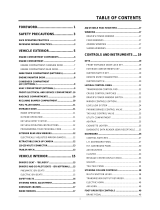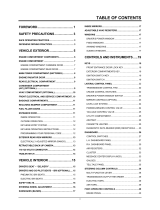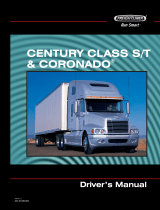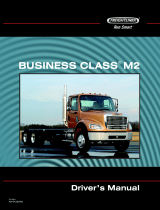Page is loading ...

COACH MANUFACTURER
OWNER’S MANUAL
LE MIRAGE XLII
BUS SHELLS
PA1565
revised 2023/06/16

PA1565 4th Edition
Date: March, 2009
Starting from vehicle: 9-9600
Featuring: Volvo D13 engine, new Allison Transmission Shift Selector and AFSS
revised 2023/07/14: light bulb data table removed

Table of contents
i
Foreword..............................1
Safety Precautions..............2
SAFE OPERATING PRACTICES ....................2
DEFENSIVE DRIVING PRACTICES................2
OTHER PRECAUTIONS ..................................3
Vehicle Exterior...................4
ENGINE COMPARTMENT COMPONENTS....6
ENGINE COMPARTMENT R.H. SIDE DOOR .8
R.H. SIDE REAR SERVICE COMPARTMENT
(XLII-45 MTH ONLY) ........................................8
DIESEL PARTICULATE FILTER (DPF)
COMPARTMENT ACCESS DOOR..................9
BAGGAGE COMPARTMENTS........................9
FUEL FILLER DOOR .....................................10
CONDENSER COMPARTMENT (A/C)..........10
ENGINE COMPARTMENT REAR DOORS ...11
110-120 VOLT CONNECTOR...........................11
RECLINING BUMPER COMPARTMENT ......12
FRONT ELECTRICAL AND SERVICE
COMPARTMENT............................................12
EVAPORATOR COMPARTMENT .................13
RADIATOR DOOR .........................................13
ENTRANCE DOOR ........................................13
KEYLESS ENTRY SYSTEM .............................14
REAR VIEW MIRRORS..................................15
BACK-UP CAMERA.......................................15
TRAILER HITCH.............................................15
Vehicle Interior .................17
DRIVER’S SEAT - DELIVERY .......................17
DRIVER'S AND CO-PILOT’S SEATS -
ISRI (OPTIONAL) ...........................................17
PNEUMATIC ISRI SEATS.................................17
ELECTRIC ISRI SEATS ....................................17
SAFETY BELTS .............................................18
STEERING WHEEL ADJUSTMENT ..............19
SUNSHADES (BLINDS) ................................19
INSIDE MIRROR ............................................19
ADJUSTABLE HVAC REGISTERS...............19
WINDOWS......................................................19
DRIVER’S POWER WINDOW ..........................19
FIXED WINDOWS.............................................19
AWNING WINDOWS.........................................19
SLIDING WINDOWS.........................................20
Controls and Instruments 21
KEYS ..............................................................22
REMOTE ENTRY TRANSMITTER ................22
IGNITION SWITCH.........................................23
LATERAL CONTROL PANEL.......................24
TRANSMISSION CONTROL PAD ....................24
CONTROL SWITCHES .....................................24
MIRROR CONTROLS .......................................25
LEVEL LOW SYSTEM ......................................25
PARKING BRAKES CONTROL VALVE............26
TAG AXLE CONTROL VALVE..........................26
CIGARETTE LIGHTER .....................................26
ASHTRAY .........................................................27
ACCESSORY POCKET ....................................27
12-VOLT DC POWER OUTLET ........................27
TRAILER AIR SUPPLY CONTROL VALVE ......27
AUTOMATIC FIRE DETECTION AND
SUPPRESSION SYSTEM (AFSS) ....................27
TIRE PRESSURE MONITORING SYSTEM
(TPMS) ..............................................................27
DASHBOARD.................................................31
CONTROL SWITCHES ..................................32
L.H. DASHBOARD PANEL ...............................32
R.H. DASHBOARD PANEL...............................35
HVAC CONTROL MODULES ...........................36
AIR VENTS .......................................................37
INSTRUMENT CLUSTER ..............................38
CLUSTER..........................................................38
MESSAGE CENTER DISPLAY (MCD) .............38
DASHBOARD GAUGES ...................................38
VEHICLE CLEARANCE INFORMATION ..........40

Table of contents
ii
TELLTALE PANEL.........................................40
STEERING COLUMN CONTROLS................44
MULTI-FUNCTION LEVER ...............................44
STEERING WHEEL CONTROLS......................45
HORNS .............................................................47
TRANSMISSION RETARDER ..........................47
FOOT-OPERATED CONTROLS....................48
SERVICE BRAKES ...........................................48
ACCELERATOR PEDAL...................................48
STEERING WHEEL ADJUSTMENT
UNLOCK AIR VALVE ........................................48
ALLISON AUTOMATIC TRANSMISSION.....48
OPERATION ....................................................49
PUSH BUTTON SHIFT SELECTOR .................49
FUNCTIONS OF THE "MODE" BUTTON .........49
TRANSMISSION SERVICE INDICATOR..........49
DESCRIPTION OF AVAILABLE RANGES........50
Other Features ..................52
EXHAUST AFTERTREATMENT SYSTEM....52
AFTERTREATMENT DEVICE ..........................52
PASSIVE REGENERATION .............................52
ACTIVE REGENERATION................................52
STATIONARY (PARKED) REGENERATION....52
MESSAGE CENTER DISPLAY (MCD)..........53
DRIVING MODE MENU ...............................54
GAUGE MODE MENU ......................................54
FUEL ECONOMY MENU ..................................54
TIME / DIST MENU ...........................................54
FAULT ? MENU (Fault messages) ....................55
NON-DRIVING MODE MENU......................55
SET UP MODE MENU ......................................55
SYSTEM DIAGNOSTIC MENU.........................57
FAULT DIAGNOSTIC MENU ............................58
PART NUMBER ................................................59
STATUS TEST ..................................................59
DATA LOG MODE MENU .................................60
PASSWORDS ...................................................60
ALLISON TRANSMISSION ELECTRONIC
CONTROLS ....................................................61
TRANSMISSION RETARDER .......................61
ENGINE BRAKE ............................................61
ANTILOCK BRAKING SYSTEM (ABS)-
AUTOMATIC TRACTION CONTROL (ATC) –
ELECTRONIC STABILITY PROGRAM (ESP)63
DRIVER CONTROLLED DIFFERENTIAL
LOCK (DCDL) ................................................63
OPERATION TIPS ............................................63
LOCKING THE DCDL .......................................64
UNLOCKING THE DCDL ..................................64
RETRACTABLE TAG AXLE..........................64
VARIABLE ASSISTANCE STEERING
GEAR (OPTIONAL)........................................64
KEYLESS ENTRY SYSTEM ..........................64
KEYLESS OPERATING INSTRUCTIONS ........65
PROGRAMMING A PERSONAL CODE ...........65
REMOTE ENTRY TRANSMITTER....................65
PROGRAMMING TRANSMITTERS..................66
SLIDE-OUT OPERATION ..............................66
SAFETY PRECAUTIONS..................................66
FRONT AND REAR SLIDE-OUT OPERATION 66
SLIDE-OUT MANUAL OVERRIDE
PROCEDURE ...................................................68
SLIDE-OUT TROUBLESHOOTING ..................71
TROUBLESHOOTING – OPERATING
CONDITIONS, CONTROL & MECHANICAL
COMPONENTS.................................................72
Starting and Stopping
Procedures ....................... 76
STARTING THE ENGINE ..............................76
STARTING FROM THE DRIVER'S SEAT.........76
STARTING FROM THE ENGINE
COMPARTMENT ..............................................76
COLD WEATHER STARTING.......................77
ENGINE BLOCK HEATER ............................78
ENGINE WARM-UP .......................................78
ALLISON TRANSMISSION WARM-UP.........78
JUMP STARTING...........................................78
ENGINE TROUBLESHOOTING
FLOWCHART.................................................80

Table of contents
iii
Safety Features and
Equipment .........................81
EMERGENCY EXITS......................................81
ELECTRIC AWNING WINDOWS......................81
ELECTRIC SLIDING WINDOWS ......................81
FIXED WINDOWS.............................................81
EMERGENCY AIR-FILL VALVES .................81
EMERGENCY AND PARKING BRAKES ......82
SAFETY EQUIPMENT....................................82
AUTOMATIC FIRE DETECTION AND
SUPPRESSION SYSTEM (ASSS)....................82
TIRE PRESSURE MONITORING SYSTEM
(TPMS) ..............................................................83
FIRE EXTINGUISHERS ....................................87
FIRST AID KIT ..................................................87
WARNING REFLECTORS ................................87
JACK AND TOOLS............................................88
SPARE PARTS KIT...........................................88
CHANGING WHEELS ....................................88
JACKING POINTS.............................................88
HYDRAULIC JACK............................................89
TOWING..........................................................89
DAYTIME RUNNING LIGHTS........................90
FOG LIGHTS ..................................................90
CORNERING AND DOCKING LIGHTS.........90
COMPARTMENT LIGHTING..........................90
MUD FLAPS AND SPLASH GUARDS..........90
BACK-UP CAMERA.......................................90
BACK-UP ALARM..........................................90
BACK-UP ALARM CANCEL SWITCH...............90
ALARM SYSTEM ...........................................90
Care and Maintenance......92
CLEANING......................................................92
SEAT UPHOLSTERY........................................92
PLASTIC AND VINYL........................................93
WINDOWS ........................................................93
STAINLESS STEEL ..........................................93
FORMICA..........................................................93
CARPET............................................................93
RUBBER COMPONENTS.................................93
FLOOR CLEANING...........................................93
EXTERIOR SURFACES....................................93
WINDSHIELD....................................................94
FLUID LEVEL VERIFICATION ......................94
ENGINE OIL LEVEL..........................................94
AUTOMATIC TRANSMISSION OIL LEVEL ......95
POWER STEERING FLUID LEVEL ..................96
COOLING FAN RIGHT ANGLE GEARBOX OIL
LEVEL ...............................................................97
DRIVE AXLE WHEEL BEARING OIL LEVEL....97
FRONT AND TAG AXLE WHEEL HUBS ..........97
COOLANT FLUID LEVEL..................................97
WINDSHIELD WASHER & HEADLIGHTS
WASHER RESERVOIRS ..................................98
OTHER VERIFICATIONS ..............................98
AIR TANK PURGE ............................................98
FIRE EXTINGUISHERS ....................................99
FUEL FILTER / WATER SEPARATOR.............99
AIR COMPRESSOR BELT TENSION
ADJUSTMENT ................................................100
FAN AND ALTERNATOR DRIVE BELTS .......100
BACK-UP CAMERA ........................................100
AIR FILTER RESTRICTION INDICATOR .......101
A/C AND HEATING SYSTEM AIR FILTERS...101
HOSE INSPECTION .......................................102
LUBRICATION ................................................102
WHEELS AND TIRES .....................................102
WHEEL BEARINGS ........................................102
SERVICE BRAKE TEST .................................102
PARKING/EMERGENCY BRAKE TEST .........102
EXTERIOR LIGHTING VERIFICATION.......103
GENERAL RECOMMENDATIONS..............104
WALK-AROUND INSPECTION
(BEFORE EVERY TRIP) ..............................105
Technical Information.... 107
DIMENSIONS AND WEIGHTS ....................108
CAPACITIES ................................................108

Table of contents
iv
FUEL TYPE ..................................................108
BIODIESEL FUELS .........................................108
WHEELS AND TIRES ..................................109
RECOMMENDED TIRE INFLATION
PRESSURE AT MAXIMUM COLD LOAD .......109
BELTS...........................................................109
ENGINE.........................................................110
TRANSMISSION...........................................110
GEAR RATIOS................................................110
PROPELLER SHAFT ...................................110
BRAKES .......................................................110
BRAKE CHAMBER EFFECTIVE AREA ..........110
AIR SYSTEM ................................................110
ANTILOCK BRAKING SYSTEM (ABS).......111
TROUBLESHOOTING AND TESTING ...........111
AUTOMATIC TRACTION CONTROL (ATC) –
ELECTRONIC STABILITY PROGRAM (ESP)
......................................................................111
STEERING....................................................111
ELECTRICAL SYSTEM................................111
SUSPENSION...............................................111
INDEPENDENT FRONT SUSPENSION.........111
DRIVE AXLE ...................................................112
TAG AXLE.......................................................112
ALIGNMENT SPECIFICATIONS .................112
INDEPENDENT FRONT SUSPENSION.........112
DRIVE AXLE ...................................................112
TAG AXLE.......................................................112
COOLING SYSTEM......................................112
FUEL SYSTEM .............................................113
EXHAUST SYSTEM .....................................113
HEATING AND AIR CONDITIONING ..........113
SMALL HVAC SYSTEM ..................................113
COMPRESSOR (for small HVAC system) ......113
CENTRAL HVAC SYSTEM .............................113
COMPRESSOR (for central HVAC system) ....113
OIL SPECIFICATIONS.................................114
ENGINE...........................................................114
AUTOMATIC TRANSMISSION .......................114
DIFFERENTIAL...............................................114
FAN RIGHT ANGLE GEARBOX .....................114
POWER STEERING RESERVOIR..................114
LIGHT BULB DATA .....................................115
PLATES AND CERTIFICATION..................116
SAFETY CERTIFICATION ..............................116
DOT CERTIFICATION PLATE ........................117
EPA ENGINE LABEL ......................................117
VEHICLE IDENTIFICATION
NUMBER (VIN).............................................117
COACH FINAL RECORD ............................117
Appendix A – SERVICE LITERATURE
......................................... 119
SERVICE LITERATURE ..............................119
NOTICE ........................................................120
Appendix B – TROUBLESHOOTING
GUIDE FOR MULTIPLEX VEHICLES ... 121
TROUBLESHOOTING .................................121
Appendix C – ALLISON DIAGNOSTIC
TROUBLESHOOTING CODES.......... 127
DIAGNOSTIC TROUBLESHOOTING CODES
(DTC) – ALLISON 4TH GENERATION
CONTROLS..................................................127
DIAGNOSTIC TROUBLESHOOTING CODES
(DTC) OVERVIEW ..........................................127
DIAGNOSTIC CODES – ALLISON 4TH
GENERATION CONTROLS............................127
DIAGNOSTIC CODE DISPLAY AND CLEARING
PROCEDURE - ALLISON 4TH GENERATION
CONTROLS ....................................................128
DIAGNOSTIC CODE RESPONSE ..................129
ALLISON TRANSMISSION DIAGNOSTIC
TROUBLESHOOTING CODES (DTC) AND
DESCRIPTIONS..............................................130
ALLISON TRANSMISSION OIL LEVEL
CHECK USING THE PUSH-BUTTON SHIFT
SELECTOR ..................................................134
CONTROL SYSTEM PROGNOSTICS.........135
OIL LIFE MONITOR ........................................135
FILTER LIFE MONITOR..................................135

Table of contents
v
TRANSMISSION HEALTH MONITOR ............136
Appendix D – DDEC VI DIAGNOSTIC
CODES ..................................139
DDEC VI DIAGNOSTIC CODES ..................139
DIAGNOSTIC SYSTEM ..................................139
READING DIAGNOSTIC CODES- FLASHING
LIGHT METHOD .............................................139
DDEC VI CPC DIAGNOSTIC CODES LIST.140
DDEC VI MCM DIAGNOSTIC CODES LIST147
Appendix E – TPMS
TROUBLESHOOTING GUIDE ...........159
Index................................161


Foreword
1
This PREVOST XLII Owner's Manual featuring
the new Volvo D13 engine available on XLII-45E
Entertainer coaches only, the new Allison
transmission shift selector and the new optional
Automatic Fire Detection and Suppression
System (AFSS) has been prepared to
thoroughly acquaint you, the owner, with
vehicle’s equipment and features in order to fully
appreciate and safely enjoy your vehicle. Of
course, you are anxious to drive your new
private motorcoach and test its features, but first
please read this publication carefully to help
ensure enjoyable and trouble free operation.
This book should be kept inside the vehicle at all
times for convenient reference. It is also
suggested that it remains with the vehicle at the
time of resale. Please notify PREVOST when
the vehicle's ownership is transferred so that our
records can be kept up to date. Do this by filling
out the appropriate form at the end of this
manual.
The specifications, descriptions and figures
given are based on the latest information
available at printing time. And because at
PREVOST we are constantly striving to improve
our products, we reserve the right to make
changes at any time without notice and/or
obligation on our part.
Please note that this publication applies to
factory-prepared, conversion-ready luxury
motorcoaches, manufactured by PREVOST. It
describes and explains the equipment and
options available for installation in our factory.
Therefore, there may be equipment described
herein that is not installed on your vehicle. This
publication also does not cover equipment
installed by your interior designer or system
manufacturer.
This manual, or portions thereof, cannot be
reproduced in any form whatsoever, in whole or
in part, without the written consent of
PREVOST.
The following words are used to emphasize
particularly important information:
DANGER
Directs the operator’s attention to unsafe
practices which could result in serious
personal injury or death.
WARNING
Directs the operator’s attention to unsafe
practices which could result in serious
personal injury or severe damage to the
vehicle.
CAUTION
Directs the operator’s attention to unsafe
practices where personal injury is not likely
but damage to vehicle components could
occur.
NOTE
Indicates supplementary information essential
to the proper operation of the vehicle.
For your own safety and to ensure prolonged
service life of your private motorcoach, heed our
warning labels: DANGER, WARNING,
CAUTION and NOTE. Ignoring them could result
in extensive damage and/or serious personal
injury.

Safety Precautions
2
To ensure safe and reliable operation, heed the
following safety precautions.
SAFE OPERATING PRACTICES
o Operation and maintenance of the vehicle
must be performed only by qualified
personnel.
o Before driving, conduct a walk around
inspection and check that all baggage
compartment doors and equipment access
doors are securely shut.
o Make sure good visibility is maintained at all
times. Keep windshields clean and free of
obstructions.
o Adjust the driver's seat so that all controls
can be reached easily.
o Always wear the safety belt when driving.
o Check the instrument panel frequently. Do
not operate the vehicle when dials or
indicators are not in their normal operating
condition.
o Always pay attention to pedestrians passing
in front and behind the vehicle. Always yield
to pedestrians at pedestrian walkways.
o Do not drive over obstacles on the road.
Empty boxes, piles of leaves, and snowdrifts
could conceal hidden dangers that could
damage the vehicle suspension and
underbody.
o When turning or changing lanes, signal your
intention well in advance.
o When approaching to make a right turn,
reduce the space between the vehicle and
the curb to make sure another vehicle
cannot pass on the right. Since the vehicle
makes wide turns, allow enough space to
make safe turns.
o Switch from high beams to low beams when
meeting or following other vehicles within
500 feet (150 meters).
o Never leave the vehicle unattended with the
engine running or with the key in the ignition.
Turn off the engine, remove keys and apply
the parking brake before leaving the vehicle.
o Shut-off the engine before refueling, adding
oil, performing maintenance or servicing
tasks, unless stated otherwise.
o Fuel is highly flammable and explosive. Do
not smoke when refueling. Keep away from
open flames or sparks.
o Do not run the engine or HVAC system with
access doors left open. Close compartment
doors before operating any equipment.
o Do not remove the surge tank filler cap or
the cooling system pressure cap when the
engine is hot. Let the engine cool down
before removing filler caps.
o Do not attempt to push or pull-start a vehicle
equipped with an automatic transmission.
o The service life of the vehicle depends on
the kind of maintenance it receives. Always
record any problems and report them
immediately to maintenance personnel.
o Do not use the trailer hitch before reading
the safety, technical and operational
requirements on page 14 of this manual.
DEFENSIVE DRIVING PRACTICES
o For city driving, allow a four to six second
travel interval between your vehicle and the
vehicle ahead. Increase this travel interval
to six to eight seconds for highway driving.
Increase time interval for driving at night or
in foul weather.
o Be prepared to stop when approaching an
intersection. The stopping distance of the
vehicle increases with the weight and speed.
o Establish eye-to-eye contact with other
drivers and with pedestrians. Use, high
beam and low beam headlights, turn signals
and horn as needed.
o On highway, don't stare at the road ahead.
Keep your eyes moving. Check mirrors and
dashboard instruments frequently.
o To keep the vehicle from drifting across
lanes during highway driving, always look
over the horizon on the road ahead.
o Adjust your speed to road conditions, traffic
and visibility. Never exceed the posted
speed limits.
o If another vehicle is following close behind,
reduce your speed to let the vehicle pass.
For additional information about safe operation
and defensive driving practices, contact the local
department of motor vehicles authority.

Safety Precautions
3
OTHER PRECAUTIONS
DANGER
Prior to working on a system inside the
vehicle, make sure to cut electrical power and
air supply. A component could be supplied
with electricity even if battery master switch is
set to the OFF position and/or a component
could be pressurized even if air tanks are
emptied. Always refer to the appropriate wiring
and pneumatic diagrams prior to working on
electrical and/or pneumatic systems.
CAUTION
Prior to welding or soldering on the vehicle,
disconnect all electronic modules, positive
and negative battery connections. If these
modules (MCM, CPC or VECU, TCM, ECU,
ABS) are not disconnected, electronic
components (EPROM, CHIPS) could be
permanently damaged.
Refer to Section 00 of your maintenance
manual for all related procedures.

Vehicle Exterior
4
XLII-45 EXTERIOR VIEW (TYPICAL)
18576
1. Engine air intake 10. Rear-view mirror
2. Engine compartment R.H. side door 11. Reclining bumper
3. Hinged rear fender 12. Front electrical and service compartment
4. Baggage compartment 13. Driver’s power window
5. Fuel filler door 14. Evaporator or baggage compartment
6. Condenser or baggage compartment 15. Radiator door
7. Entrance door 16. Diesel Particulate Filter (DPF) compartment
access door
8. Entrance door power window 17. R.H. side rear service compartment
9. Engine compartment rear doors

Vehicle Exterior
5
XLII-45E EXTERIOR VIEW (TYPICAL)
18622
1. Engine air intake 9. Engine compartment rear doors
2. Engine compartment R.H. side door 10. Rear-view mirror
3. Hinged rear fender 11. Reclining bumper
4. Baggage compartment 12. Front electrical and service compartment
5. Fuel filler door 13. Driver’s power window
6. Condenser or baggage compartment 14. Evaporator or baggage compartment
7. Entrance door 15. Radiator door
8. Entrance door power window
16.
17.
Diesel Particulate Filter (DPF) compartment
access door
Front Slide-Out (Optional)

Vehicle Exterior
6
ENGINE COMPARTMENT COMPONENTS
ENGINE COMPARTMENT FEATURING DDC SERIES 60 ENGINE 01186A
1. Coolant fluid surge tank;
2. Engine oil dipstick;
3. Belt tensioner control valve;
4. Engine oil reserve tank;
5. Hydraulic Fluid Reservoir;
6. Starter selector switch and Engine rear start
push-button switch, Engine Compartment
Lights Switch;
7. Radiator;
8. Radiator fan drive mechanism support;
9. Engine oil filler tube;
10. Alternator;
11. Small HVAC system compressor;
12. Air filter;
13. Transmission oil dipstick and filler tube.

Vehicle Exterior
7
ENGINE COMPARTMENT FEATURING VOLVO D13 ENGINE AVAILABLE ON ENTERTAINER COACHES ONLY
01184
1. Diesel Particulate Filter (DPF);
2. Transmission fluid dipstick;
3. Coolant fluid surge tank filler cap;
4. Coolant fluid surge tank sight glass;
5. Air filter restriction indicator;
6. Engine oil dipstick;
7. Belt tensioner control valve;
8. Starter selector switch and Engine rear start push-button switch, Engine compartment Lights Switch;
9. Power steering fluid reservoir;
10. Radiator and charge air cooler;
11. Radiator fan drive mechanism support;
12. Alternators;
13. Engine oil filler tube;
14. Central A/C compressor;
15. Air filter;
Small A/C compressor (if equipped with parcel rack cooling system);

Vehicle Exterior
8
Most serviceable parts may be accessed
through exterior compartments. There may be
slight differences in the location of parts and in
the configuration of compartments between
models, depending on options.
ENGINE COMPARTMENT R.H. SIDE
DOOR
The engine compartment R.H. side door
provides access to the following (if equipped):
o Engine compartment rear door release
lever;
o Batteries;
o Battery equalizer;
o Voltage regulator;(w/270A alternator only)
o Circuit breakers Panel;
o Rear Junction Box;
o Booster terminals;
o Alternator(s);
o Allison Transmission Control Module (TCM);
o Primary air circuit fill valve and drain cock;
o Fuel filter/water separator;
o Cold weather starting fluid bottle;
o 110-120 volt connector.
o A/C Compressor.
ENGINE COMPARTMENT R.H. DOOR
18559
This door can be locked or unlocked using the
exterior compartment key or, if so equipped, by
the central door locking system. To open, push
sideways the small lever located between the
marker lights.
ENGINE COMPARTMENT R.H. SIDE
18513
Turn ON the lights in the engine compartment
using a switch on the rear start panel.
REAR START PANEL
06409
WARNING
Unless otherwise stated, do not run the
engine when the engine R.H. side
compartment door is open. Close engine R.H.
side compartment door before starting engine.
R.H. SIDE REAR SERVICE
COMPARTMENT (XLII-45 MTH ONLY)
This compartment is closed off from the engine
compartment and can be used for storage or to
house custom mechanical components.
To open the door, first open the engine
compartment R.H. side door and push the lever
located near the lower door hinge down.

Vehicle Exterior
9
LEVER IN ENGINE COMPARTMENT
18372
Lights in the compartment turn ON automatically
when the door is opened.
DIESEL PARTICULATE FILTER (DPF)
COMPARTMENT ACCESS DOOR
To gain access to the DPF, open the radiator
door first. At the top of the radiator compartment,
pull the catch connecting rod to unlock the DPF
compartment access door and lift the door open.
Hold the door open by inserting the support rod
free end into the receptacle located on the left
side of the DPF.
ACCESS TO THE DPF
04018
WARNING
After inserting the support rod into the
receptacle, make sure the rod supports the
door securely from falling down on to your
head or body.
WARNING
External and internal temperatures remain hot
long after engine has been shutdown. Allow
the Aftertreatment Device and DPF to cool
before handling. Wear protective clothing and
glove while servicing.
BAGGAGE COMPARTMENTS
BAGGAGE DOOR LOCK AND LEVER
18043
The baggage compartment doors of the XLII-45
model provide 407 ft
3
(11,53 m
3
) of storage
capacity. The compartments can be locked or
unlocked by using the exterior compartment key.
Pull up operating handle to release the latch,
and then pull the door open. Pressurized
cylinders assist the opening and closing of the
baggage compartment doors and hold the doors
open.
To close, pull the door down by the handle rod.
Complete the closing of the door by returning
the operating handle to its initial position.
CAUTION
Do not slam shut the baggage compartment
doors. Damage to door weather-stripping or
locking mechanism could result.

Vehicle Exterior
10
Lights in the baggage compartments turn ON
automatically when the door is opened.
WARNING
To avoid injury, keep hands clear of baggage
compartment door edge and door frame when
closing.
NOTE
To prevent theft and vandalism, always lock
the baggage compartment doors before
leaving the vehicle unattended.
NOTE
For added safety, use the safety lock to keep
the door securely opened.
SAFETY LOCK
18038
NOTE
The baggage compartment doors can be
locked/unlocked from the driver's position by
the optional central locking system. The switch
is on the L.H. control panel. Refer to "Controls
& Instruments" chapter.
FUEL FILLER DOOR
There is one fuel filler door on each side of the
vehicle, providing easy fuel filling. Both fuel filler
doors can be unlocked with the exterior
compartment key. Springs keep the door either
open or shut.
NOTE
Provided the vehicle is parked on level
ground, an automatic nozzle will automatically
shut off when tank is approximately 95% full.
CAUTION
Do not fill to more than 95% of the tank
capacity. Do not "top off" the tank, doing so
may result in fuel spillage when the fuel
expands.
NOTE
The fuel filler door locks must be in the
unlocked position before closing.
CONDENSER COMPARTMENT (A/C)
Pull the release latch located inside the adjacent
baggage compartment to open the condenser
door.
The condenser compartment provides access to
the following:
• Condenser;
• Condenser fans and motors;
• Filter dryer and moisture indicator;
•
Receiver tank.
CONDENSER DOOR
18378

Vehicle Exterior
11
CONDENSER COMPARTMENT (A/C)
ENGINE COMPARTMENT REAR
DOORS
To open the engine compartment rear doors,
open the engine compartment R.H. side door
and pull the lever located on the rear door, close
to the bottom door hinge. The engine
compartment doors swing out to provide access
to the following:
o Engine;
o Alternator(s);
o Compressor(s);
OPENING THE ENGINE COMPARTMENT REAR DOORS
FROM R.H. SIDE DOOR
18547
o Belt tension valve (refer to Care and
Maintenance chapter);
o Engine starting selector (refer to Starting
and Stopping Procedures chapter);
o Certification plates;
o Engine coolant surge tank;
o Air cleaner restriction indicator;
o Engine oil dipstick;
o Engine oil reserve tank;
o Power steering fluid reserve tank;
o Automatic transmission oil dipstick and filler
tube;
o Engine coolant filler cap.
A catch holding each door open engages when
the door is fully open. Release the catches
before closing the doors. Close the L.H. door
first, then firmly shut the R.H. door.
REAR START PANEL
06409
Turn the lights ON in the engine compartment
using the switch on the rear start panel.
WARNING
Unless otherwise specified, do not run engine
when the engine compartment rear doors are
open. Close the engine compartment rear
doors before starting the engine.
110-120 VOLT CONNECTOR
This connector is used with a 110-120 volt
supply and is connected to the engine block
heater. Refer to "Starting and Stopping
Procedures" chapter.

Vehicle Exterior
12
110 VOLT CONNECTOR
06390
To access the connector, open the engine
compartment R. H. side door. The connector is
attached to the L. H. side frame post.
RECLINING BUMPER
COMPARTMENT
The front bumper can be tilted downward to give
access to the bumper compartment. Pull the
release handle located inside front service
compartment to unlock. Tilt down the entire
bumper assembly to access the compartment.
Push the bumper back up firmly in place to lock
in position.
WARNING
The compartment behind the bumper is not
designed for storage. Never store loose
objects in this compartment since they can
interfere with the steering linkage mechanism.
Use care when opening or closing the
reclining bumper compartment to prevent
personal injury.
FRONT ELECTRICAL AND SERVICE
COMPARTMENT
To open the front electrical and service
compartment door, pull the rod inside the
vehicle, next to the driver’s power window or use
the key to open from outside the vehicle. The
front electrical and service compartment
provides access to the following:
FRONT SERVICE COMPARTMENT DOOR
18381
o Front terminal block;
o CECM and CPC;
o Vehicle Electrical Center Front (VECF) and
Multiplex Modules;
o Keyless module;
o Relays and fuses;
o Windshield washer reservoir & headlights
washer reservoir;
o Accessory air tank drain valve;
o Accessory system fill valve;
o ABS Electronic Control Unit (ECU).
The light in the front electric & service
compartment turns ON automatically when the
door is opened.
FRONT ELECTRICAL COMPARTMENT
06665
/

















